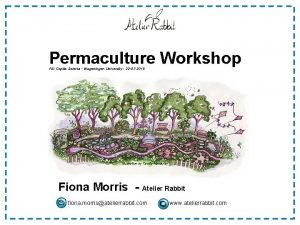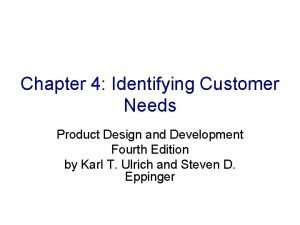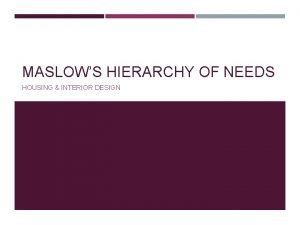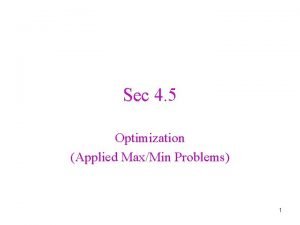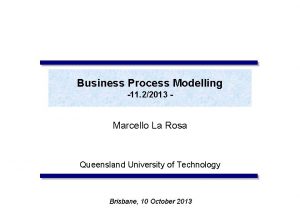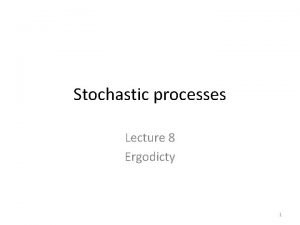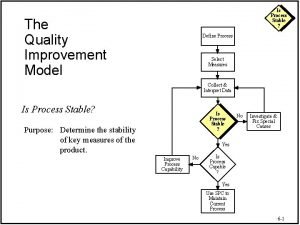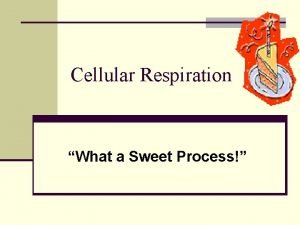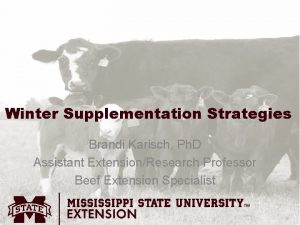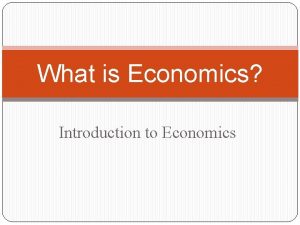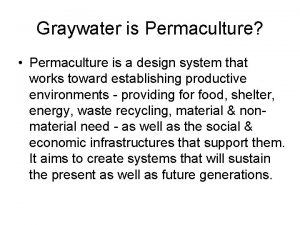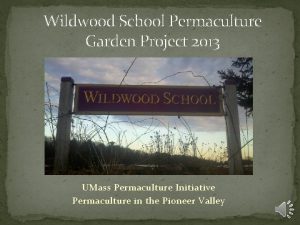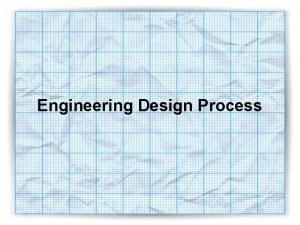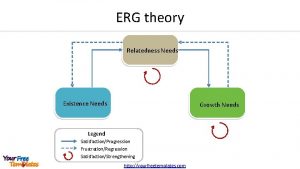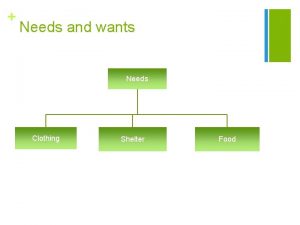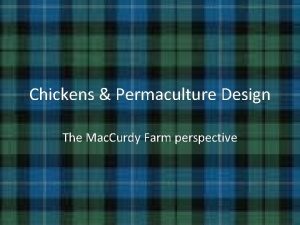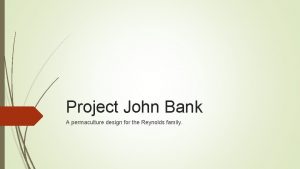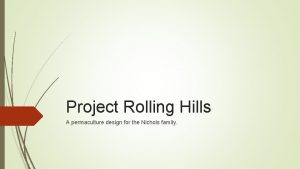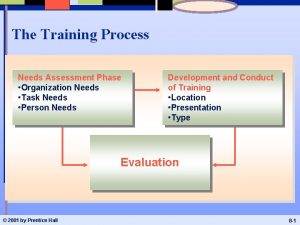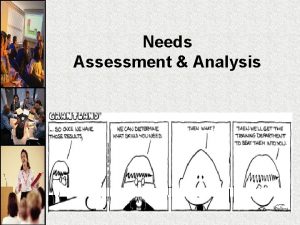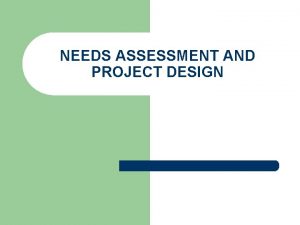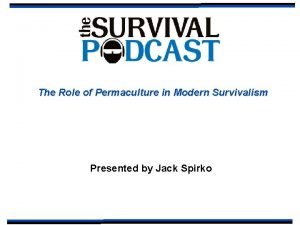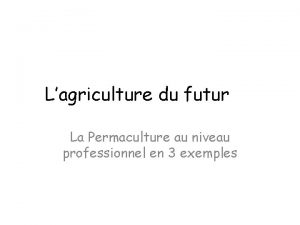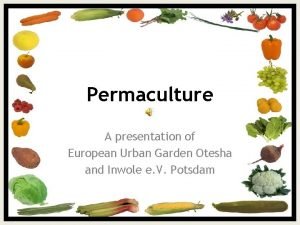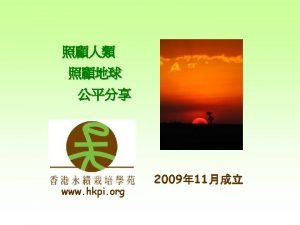PERMACULTURE Permaculture Design Permaculture Design Process Needs of


























- Slides: 26

PERMACULTURE Permaculture Design

Permaculture Design Process Needs of the space/Client Interview Base Map of the Property

Base Map of Property

Permaculture Design Process Needs of the space/Client Interview Base Map of the Property Observation Sector Analysis

Sector Analysis • Wind sector • Sun sector • Shade sector • Wildlife sector • Waterway sector • Fire break • Access sector

Permaculture Design Process Needs of the space/Client Interview Base Map of the Property Observation Sector Analysis Water Analysis Soil & Nutrient Sources on Site Microclimates

Soil & Nutrients on Site Types of Soil: Ø Clay Ø Silt Ø Sand Ø Loam Soil Tests: Ø The Squeeze Test Ø The Percolation Test Ø The Worm Test Ø The Ph Test Ø The Mason Jar Test 20% clay, 40% Silt, 40% sand = Loam 30% clay, 60% silt, 10% sand = Silty Clay Loam 15% clay, 20% silt, 65% sand = Sandy Loam 15% clay, 65% silt, 20% sand = Silty Loam

Micro Climates Microclimates are spaces in any given landscape where the temperature and climate significantly differ from the immediate surroundings. Microclimates occur naturally in the natural world and can also be created through human design. They depend on the concentration of certain natural elements in specific places.

Permaculture Design Process Needs of the space/Client Interview Base Map of the Property Observation Sector Analysis Water Analysis Soil & Nutrient Sources on Site Microclimates Zone & Broad Design Placement Poorly Placed Elements

Zones Zoning – zone 0 – zone 1 – zone 2 – zone 3 – zone 4 – zone 5

Relative Location

Permaculture Design Process Needs of the space/Client Interview Base Map of the Property Observation Sector Analysis Water Analysis Soil & Nutrient Sources on Site Microclimates Zone & Broad Design Placement Poorly Placed Elements Detailed Design

Food Forest gardening is a low-maintenance sustainable plant-based food production and agroforestry system based on woodland ecosystems, incorporating fruit and nut trees, shrubs, herbs, vines and perennial vegetables which have yields directly useful to humans.

7 Layers of a Food Forrest

Stacking & Natural Succession * Slash & mulch * Build small * Progressive planting * Add over time

Multiple Functions • wind break • boundary • habitat • Food • wood/fuel

Guilds Diversity equals Stability – Avoid ‘Monocrops’, create ‘Guilds’ – Create ‘Microclimates’ and multi-purpose spaces

What to Include in Garden? Culinary Herbs Medicinal Herbs Dynamic accumulators (soil builders) like comfrey and borage Mixed Berries Annual Veggies Fruit Trees Misjudged Weeds Bio. Diversity

What Plants to choose & Considerations: Seasonal Water, wind & Sun they can take What soil quality to they like? Ph? How much space do they need (width, breath) What other plants can support this plant (Companion Planting) What plants should you avoid planting near this one Are they an annual or Perennial Add nitrogen fixing plants Add Dynamic Accumulators Diversity

Annuals & Perennials

Dynamic Accumulators Certain plants (often deep-rooted ones) will draw up nutrients from the lower layers of the soil, and these nutrients will be stored in the plants’ leaves. When the leaves fall in autumn and winter and are broken down, those stored nutrients are then incorporated into the upper layers of the soil where other plants will benefit from their deposition.

Nitrogen Fixing Plants

The Benefits of Companion Planting Vegetables Shelter - larger plants protect others from wind or too much sun. Support - Some vegetables can be used as physical supports for others. As an example, pole beans planted with corn use the corn as a trellis. Beneficial Insects - attracting beneficial insects such as bees help spread pollen. Soil Improvement - some vegetable plants improve soil conditions for other plants. For example, members of the legume family (beans etc. ) draw nitrogen from the atmosphere and add it to the soil around them. Decoy Plants - there are plants that emit odors that aid in masking the odors of insect-desirable vegetable plants.

Mulching

H. W Design Exercise Group up or Individual Use Existing Land or Imaginary Community Garden Make a base Map + Sector Analysis Be clear on the intention of the space Come up with 1 example of guilds to put on your space Make a Design Present Your Design to the Group Time: 1 hour

Final Design
 Permaculture ethics and principles
Permaculture ethics and principles Capita selecta wur
Capita selecta wur Primary needs and secondary needs
Primary needs and secondary needs Satisfaction
Satisfaction Alpha press murray
Alpha press murray Strategic gender needs and practical gender needs
Strategic gender needs and practical gender needs Present situation analysis
Present situation analysis Methods of identifying customer needs
Methods of identifying customer needs Design hierarchy of needs
Design hierarchy of needs A company needs to design a cylindrical can that holds 475
A company needs to design a cylindrical can that holds 475 Process design and control design should always be in
Process design and control design should always be in Os coxae
Os coxae Procedural due process vs substantive due process
Procedural due process vs substantive due process Business process levels
Business process levels Ergodicty
Ergodicty What is process to process delivery
What is process to process delivery Condylar process and coronoid process
Condylar process and coronoid process Stable process has to be a capable process
Stable process has to be a capable process Process-to-process delivery
Process-to-process delivery Sweet process
Sweet process Summative and subjective assessment
Summative and subjective assessment Needs and wants
Needs and wants Personality pyramid
Personality pyramid Kinetic energy
Kinetic energy Brandi needs her protein
Brandi needs her protein Glasser's basic needs
Glasser's basic needs Needs vs wants examples
Needs vs wants examples

